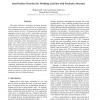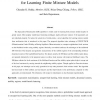264 search results - page 17 / 53 » Factorial Learning and the EM Algorithm |
CVPR
2012
IEEE
11 years 10 months ago
2012
IEEE
This paper addresses recognition of human activities with stochastic structure, characterized by variable spacetime arrangements of primitive actions, and conducted by a variable ...
ICML
1997
IEEE
14 years 8 months ago
1997
IEEE
In recent years there has been a flurry of works on learning probabilistic belief networks. Current state of the art methods have been shown to be successful for two learning scen...
PAMI
2008
13 years 7 months ago
2008
The Expectation Maximization (EM) algorithm is widely used for learning finite mixture models despite its greedy nature. Most popular model-based clustering techniques might yield...
ML
2007
ACM
13 years 7 months ago
2007
ACM
Abstract Surrogate maximization (or minimization) (SM) algorithms are a family of algorithms that can be regarded as a generalization of expectation-maximization (EM) algorithms. A...
JMLR
2002
13 years 7 months ago
2002
We examine the learning-curve sampling method, an approach for applying machinelearning algorithms to large data sets. The approach is based on the observation that the computatio...


